Physics in the MIT by Yan Z. '12
No bacon apple pies here.
Today I neglected to bring a jacket to class. As the afternoon waned impassively toward night, the last hanging breaths of August condensed into soupy grey cold specked with watery yellow sunstreaks. By conservative estimates, I caught six different strains of flu on the way home at 6:30 pm. Nonetheless, after a quick homemade dinner of soba, ginger, almonds, and dewy-fresh vegetables from MIT’s weekly farmer’s market, I barely noticed the initial symptoms of tuberculosis.
On the flip side of the burger (to coin a stupid-sounding idiom), I no longer have an excuse for putting off this blog entry until T_n, where T_n > 5 minutes from now. A week or so ago, Becky from somewhere-recently-visited-by-Quentin-McArthur emailed me a laundry list of excellent questions that I could answer in less time than most questions I encounter on an hourly basis. I started to write back, “Thanks, Becky! It’s so nice to make human communication once in a while! See you on the Internet sometime,” and then I figured that she probably wanted me to answer her questions instead of becoming her Facebook buddy. (Curmudgeonly aside: It’s a sad, sad world when I get more Facebook friend requests than personal emails. Also, you kids get off my lawn.)
Hi Yan –
When Quinton McArthur came to our school the other day, I asked him a
question about the physics department at MIT, and he directed me to you. I
actually have more than one question, but they’re roughly in order of
importance if you don’t have time to answer them all.
It’s 12:50 AM! Of course I have time.
Questions:
1. UROP seems like it would allow you to do awesome research as an
undergrad. Has this been your experience? Is there anything about physics
UROPs that make them different? Are experimental and theoretical research
opportunities both available to undergrads? How do students make time for
research during the academic year, or do most students do UROPs during the
summer?
UROP, MIT’s undergrad research program, has improved my overall standard of living as well as my GDP and average lifespan. My first research group in the Materials Science department paid 11 bucks an hour, which was increased to $12/hour over the summer, for me to build and test batteries that wouldn’t explode or melt or otherwise make a huge, expensive mess and ruin everyone’s life. I eventually started running out of work to do after one semester, so I adopted a second UROP in the Plasma and Fusion Center writing scripts to decipher NASA spacecraft data and explain the mysterious phenomenon of magnetic reconnection. After one month, I started to think in MATLAB instead of in English, but it was nonetheless an enjoyable introduction to physics research.
UROPs are more common during IAP and Summer, but plenty of people (like me) devote up to 6 hours per week to research, usually after class on weekdays. Think of it as like taking half a class while getting paid. It’s a valuable way to learn relevant skills for your field while getting rich at a very, very slow rate.
All professors in the Physics department that I’ve met so far have been open to sponsoring undergrad research. At least one requires that his students take 8.04 (quantum) before doing research in his group. However, most labs, experimental and theoretical, could always use the extra help with coding and performing routine tasks traditionally reserved for intelligent primates and large, powerful computers. (Well, maybe not the string theorists. Or LIGO, since LIGO was crowded with UROPs last time I applied for one in their group.) You might not get an intellectually dazzling UROP during your first years at MIT, but it’s well worth the experience.
2. In a blog post from December, 2007, Lulu wrote that around 13/50 of
physics majors (just for course 8, not 8-B) are women. Do you think this
estimate is accurate? Do you notice this imbalance at all? Does it not
matter because the overall Institute gender numbers are essentially equal?
Does it not matter just because it doesn’t matter whether the people
you’re doing physics with are girls or guys? Have you had any
gender-related problems (academic or otherwise) as a physics major
specifically?
Gender imbalance has never influenced my experience at MIT. I’m a bit startled by your (Lulu’s?) numbers, since at least half of the Physics majors I’ve met are women. Granted, I spend a lot of time around Undergraduate Women in Physics, which is perhaps not a representative sample of the gender distribution.
Then again, the mere existence of a group at MIT dedicated to providing support for female physicists suggests that your speculations are valid. I’ve also heard from professors that more men tend to take the advanced versions of intro Physics classes, such as 8.022. However, personal evidence shows that more women tend to wake up in time for lecture. (At least when McGreevy taught it.)
3. I remember at least Chris S. blogging about how his biology psets and
tests test more his ability to think and solve problems than his
memorization skills. Is there a similar emphasis on thinking over
memorizing in the physics classes?
Yes. At least for the intro classes, all relevant formulae as well as useful math identities are provided with each exam. (However, this doesn’t mean that you shouldn’t understand the derivations in all their gory intricacies.) MIT generally tries to ensure that you will never fail because you spent too much time on a test trying to remember the dimensionless factor in the denominator of the Larmor formula (6*pi in SI units, 3/2 in CGS).
Problem sets, similarly, require a lot of braining. This page of my 8.03 pset aptly summarizes life as a Physics major at MIT.
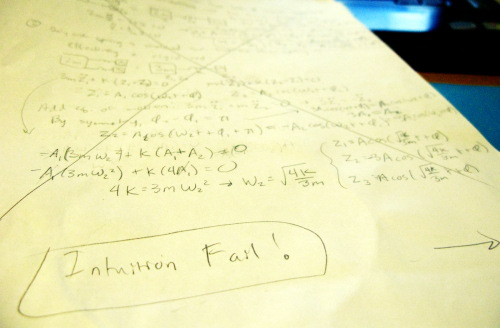
(After taking a shortcut that failed to reach the intended destination, i.e., the correct answer.)
4. I don’t know how well you know the math department, but do you know
where on the spectrum from super applied to super theoretical the math
department classes usually fall? Or are they all over the place? Do most
physics majors end up taking classes at a certain point on this spectrum?
If you look at the math department course catalog, you’ll notice sections subtitled “Applied Math,” “General Math,” “Analysis”, “Theoretical Comp. Sci.,” etc. Math tends to be the all-purpose flour in MIT’s curriculum pantry. A “typical” math class doesn’t really exist; there’s more than enough choices for you to fine-tune the level of applicability until it resonates with your interests. Analysis classes tend to be theoretical, whereas applied math is geared toward engineers, which I just nearly spelled “gearineers.” Time for bed.
Also, I know at least one physics major who accidentally took enough theoretical math classes to get a second major in Course 18. Most people, at least those who aren’t into intense theory, go with just 18.03, 18.06 (or a variant thereof), and 18.04 or an applied math class.
Thank you,
Betsy [last name omitted to create a feeling of suspense]
No problem, Betsy! Want to see my problem sets for this week? Really, you do? Okay!
To be honest, my problem solving skills this week fell short of robust. The trouble started with the double pendulum problem on the 8.03 (Waves n’ Vibrations) problem set, which I naively crammed into the Lagrangian instead of kickin’ it old-school with a force balance diagram. I’m one of those people who use the Lagrangian to calculate the net force on an object falling from rest, you know.
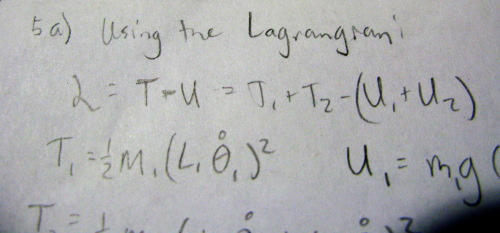
Anyway, this happened:
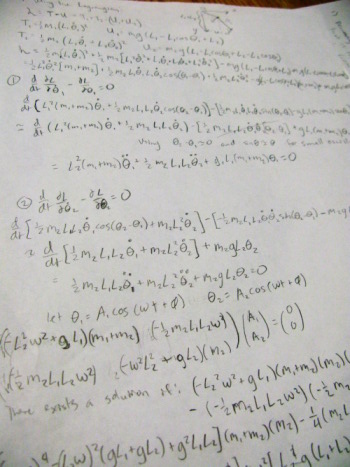
1.5 pages later, the moral of the story was pummeling me in the face. Live and learn but don’t Lagrange. Lagrange isn’t even a verb.
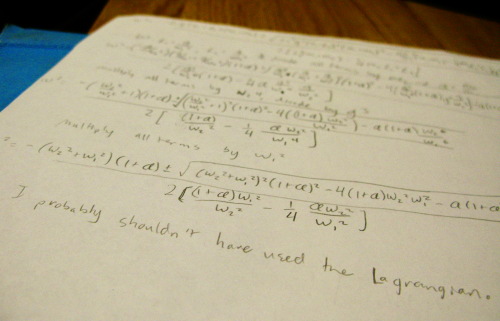
I reworked the problem later and massaged out the hideous lumps of unsimply simplified terms by dousing everything in a small angle approximation that was much, much smaller than what I consider to be a kosher small angle approximation. It was during Yom Kippur, after all.
The second sign of impending toil came in an email from the 8.033 (Special Relativity) TA last night that basically read, “Sorry, forgot to mention that you need to show calculations for Problems 2 and 3 instead of just drawing diagrams, because you probably skipped art class in high school anyway.” The only problem was that I had already finished the problem set and, like residents of Manhattan slums during the early factory era, I had no space left.
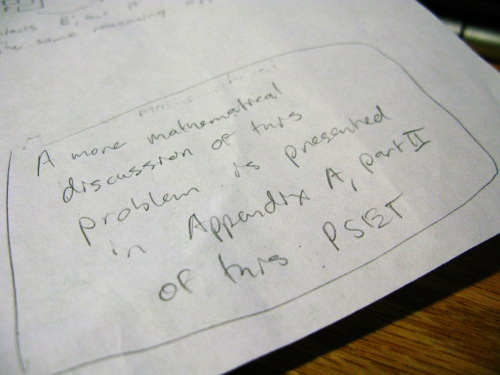
Appendix A turned out to be pretty much the most beautiful thing that I have ever created with my bare hands.
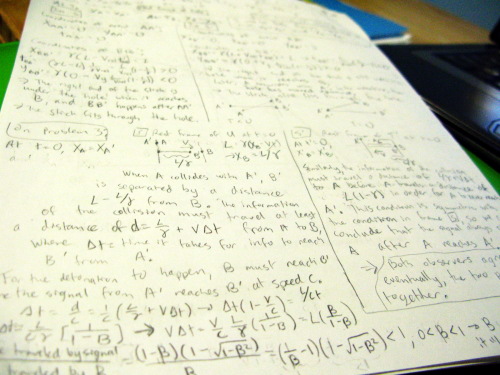
My 8.07 (Electricity and Magnetism II) problem set this week was blissfully merciful, except that everything equivalency statement I tried to prove turned out to be off by either a factor of 2 or a factor of sqrt(c). Did you know that the square root of a meter per second is a fundamental dimensional quantity in both electromagnetic momentum and energy flux? Neither did I.
Sometimes, frustration begs to be cartoonified.
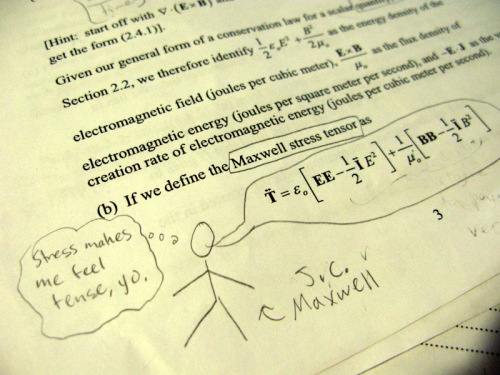
Inspired by Professor Belcher’s mathematically gorgeous field line representations (check them out- as a bonus, the animated ones also make excellent music visualizers), I took a break from work to relax, refresh, and reinterpreted a Van Gogh painting as an electric/magnetic field diagram.
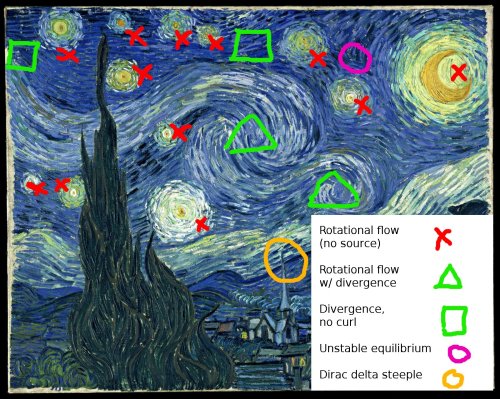
Yep, this qualifies as a break from work.
@Yan:
you are correct and yeah it is true
but it is somewhat fun for me writing so
According to
http://web.mit.edu/registrar/stats/yrpts/index.html and
http://web.mit.edu/registrar/stats/gender/index.html
about one-third of physics majors are women, and about 40% of the most recent class reported.
I’m intimidate by your photos =(
Oops, should be “intimidated”.
They do look tiring tho.
Bah, it’s not cold yet
first to say first!!!!

Yep, that was definitely Lulu’s comment.
See:
http://www.mitadmissions.org/topics/learning/majors_minors/choosing_a_major.shtml
Thanks for the answers and accompanying photos, Yan! Of course I wanted to see your problem sets (I’m not being sarcastic – it was actually cool to see what you’re working on). And Matt, thanks for those numbers.
(I’m not being sarcastic – it was actually cool to see what you’re working on). And Matt, thanks for those numbers.
Nice PSETs!
I love your Van Gogh interpretation.
Nice, helpful post!
I also loved the van Gogh interpretation ^^
Yep. That’s what she said.
I like your Appendix A.
Lolololol up to 6 hours per week… or if you’re in the math department and getting paid $9.25/hour up to 9 hours/week…… or if you’re organizing an event/doing something exciting, much more than that!! Hahaha.
@ Navin:
Not an accomplishment!
@ Anonymous 2:
Good call. Wait . . . I think so.
@ Lauren:
Chocolate Soiree? Was that part of your UROP?
I love the way you mess with the painting for a break! It’s like you can expose science everywhere including art. Nice job, keep answering us these kinds of questions! It helps a lot :D
After reading the NYT article and following the link, I found your blog and ended up reading all of the entries. I have to say you are an amazing writer (though your earlier entries are the best). You could write for a major magazine/newspaper today! You have a bright future ahead of you, and I look forward to great things from you.
(me: not a MIT person, though I did apply and get in – this was many years ago)
Physics and art, what a great combination!
I would say, ‘Physics is Beautiful’, its beauty lies in the fact that after understanding those small ‘complex’ equations we are able to understand the underlying complex nature of the universe. That is wonderful !
By the way, demonstrations and experiments in physics are the best part !
So, I have also decided to join all of you, friends to study physics there from 2010 in MIT !
Question: how long is your average physics pset? Are they typically that length, or do they all vary?
I also love how the girl who emailed you’s name changes from Becky to Betsy
I love your blog! really interesting and helpful responses to the questions, thanks. and those problem sets look ridiculously fun/scary.
Yan,
Your post was excellent! I am not a prospective student but the father ofa (hopefully) prospective (almost 13) year girl. Being an electronics engineer from India, and a compsci ph.d. here, I am jealous of your learning (I wished they taught me this types when I was late teens). Lagranging way into the nights (thanks for making it a verb) was so exciting, I felt like going back to school.
I sincerely appreciate you guys spending so much time showing off science. It is what we need in USA, and please continue to do so.
THE VAN GOUGH ANALYSIS = BRILLLIANNNNTTTTT
Criminy… this is so awesome. Dare I clutter up your wonderful space with my admiration? Like kumar above, I have no connection with MIT whatsoever (except my son-in-law’s parents live in Cambridge), and I have known a few MIT grads. I, too, just followed the nytimes link here. May god(s) bless the gray lady.
I just want to say how envious I am of you folks who understand physics beyond f=ma. I am a pretty smart guy; not sure if I am MIT smart (I got 800 on my math SATs and went to Rice, so maybe). I am a chemist and pharmacologist and physician, but I feel like there is a huge hole in my life that I was never really exposed to quantum mechanics or Dirac nor do I have a clue about string theory or Riemannian geometry or any of the stuff that explains the universe. It feels just as much a fundamental deficiency as if I were ignorant of acids and bases or the periodic table. I wonder if I could make it through physics for first and second year physics majors at MIT.
Anyhow, I just had to leave this to say “rex was here” and congratulate you for making it necessary to have Undergraduate Women in Physics. And I look forward to you and all those “14?” other bloggers making the world a better place for my grandchildren (if I ever have any someday).
Hi nice to meet you.
I am a japanese.
I graduated a university in Japan.
My major was biology.
I want to study Mathematics, Physics. and interested in some other part of science.
But I dont know how I can study in MIT.undergraduate? freshman course? UROP?
I am attend to Overnight host program in this October.
if possible, I woud like to meet you and get some information about Physics in MIT.
Ryo Yamanishi
Yan: Have you heard of / read [url=”http://press.princeton.edu/titles/8509.html” rel=”nofollow”]Fearful Symmetry:
The Search for Beauty in Modern Physics[/url]? I read 1/3 of it and would like to finish the rest… the next time I hang out at the local bookstore.
Way to interpret Van Gogh, I loved it.
And those problem sets are really intimidating, but they actually inspire you to understand them.
Just to say what I think that has been said a lot of times already: You are a great writer. Your blog amuses me.
What kind of pencil do you use? Your lines are so crisp that I imagine it must be mechanical.
@ Landon:
I prefer pen, but the low friction coefficient makes my handwriting look more warbled than it is already. I also skipped career fair this year, so I have a sore lack of pens right now. These days, I use mechanical pencils exclusively (0.7 or 0.5 lead. Preferably 0.5, but I lost all my 0.5 pencils.)
Interestingly, the more intricate the problem, the neater my handwriting becomes.
Call me crazy, but… is it odd that my first impulse upon seeing your pset was not of an intimidatory nature [i’m 96% sure that’s not even a word], but rather an “omg, I want to learn exactly how to do that!”?
While my prospects of getting into MIT are dim indeed [no AP classes, etc], I can’t help but be dazzled by the school’s vibrant community/outlook and dedication to the furthering of scientific knowledge. Good luck on your continued coursework, Yan, you’re my favorite blogger!
dear Yan
Thank you very much!
I will try to visit them.
thanks a lot.
ryo
@Ka-Wiz:
Don’t give up hope! I took approx. zero AP classes and didn’t finish high school. Just keep learning.
Oh, and thanks for the luck.
@ Ryo:
No problem. Have a good visit!
Haha… should be tooling off for 8.022, but instead, I procrastinate on this. Lol, E&M will make you see div, grad curls everywhere, including, in this case Van Gogh painting.
Thanks, guys!
@ Madeleine:
All evidence suggests that her name actually is Betsy, unless I’m secretly going dyslecksik.
My average PSET varies from 5 to 8 hours long. Up to 4 hours of that can just consist of checking and trying to unknot algebra mistakes though.
@ Ryo:
You can get an info session/tour at the admissions office when you visit. They’ll probably be much more helpful and much less sleep deprived than I, unless you happen to talk to Paul Kominers (in terms of sleep dep., not helpfulness).
@ Quantumdot:
Thanks for the recommendation! I’ve read the Blake poem. I’ve listened to John Adam’s Fearful Symmetries. I guess I need to read the book now.
@ Anonymous:
Good luck! Remember to use your right hand. (Seriously, I’ve lost like 10 points total on 8.022 tests because of this.)
hey
h are u?